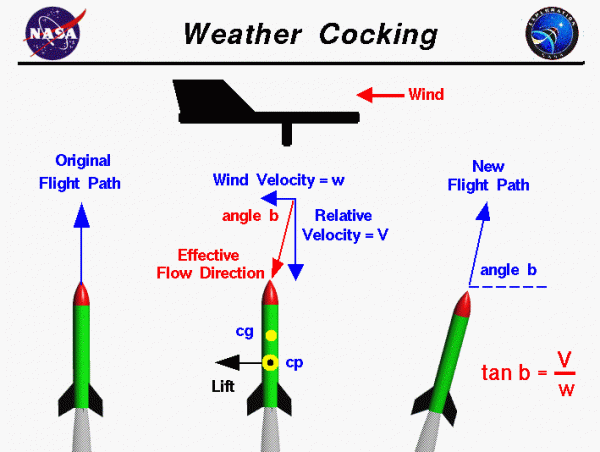Rocket Weathercocking

Weathercocking
Following the liftoff of a model rocket, it often turns into the wind. This maneuver is called weather cocking and it is caused by aerodynamic forces on the rocket. The term weathercocking is derived from the action of a weathervane which is shown in black at the top of the figure. A weathervane is often found on the roof of a barn. It pivots about the vertical bar and always points into the wind. Older, more artistic weathervanes used the figure of a rooster with large flaring tail feathers instead of the wing shown on the figure. This type of weathervane was called a weathercock.
Why does Weathercocking Occur?
As the rocket accelerates away from the launch pad, the velocity increases and the aerodynamic forces on the rocket increase. Aerodynamic forces depend on the square of the velocity of the air passing the vehicle. If no wind were present, the flight path would be vertical as shown at the left of the figure, and the relative air velocity would also be vertical and in a direction opposite to the flight path. If you were on the rocket, the air would appear to move past you toward the rear of the rocket.
What does Velocity Accounts for?
The velocity of an object is a vector quantity having both a magnitude and a direction and when discussing velocities, we must account for both magnitude and direction. The wind introduces an additional velocity component perpendicular to the flight path, as shown in the middle of the figure. The addition of this component produces an effective flow direction shown in red on the figure. The effective flow direction is inclined to the horizontal at an angle which we shall call angle b. The size of angle b depends on the relative magnitude of the wind and the rocket velocity.
Since the effective flow is inclined to the rocket axis, an aerodynamic lift force is generated by the rocket body and fins. The lift force acts through the center of pressure cp of the rocket. For stability reasons, the cp is located below the center of gravity cg. The lift force generates a torque about the cg which causes the rocket to rotate.
New Flight Path
The rotation of the rocket produces a new flight path into the wind, as shown on the right of the figure. When the new flight path is aligned with the effective flow direction, there is no longer any lift force generated and the rocket continues to fly in the new flight direction. The flight path is inclined to the horizontal at angle b. We can determine this angle by considering the middle of the figure. If the wind velocity is w and the flight velocity is V, then:
\(\LARGE \tan b=\frac{V}{w}\)
where “tan” is the trigonometric tangent function. Weathercocking reduces the maximum altitude which a model rocket can achieve, since the flight path is inclined from the vertical.
